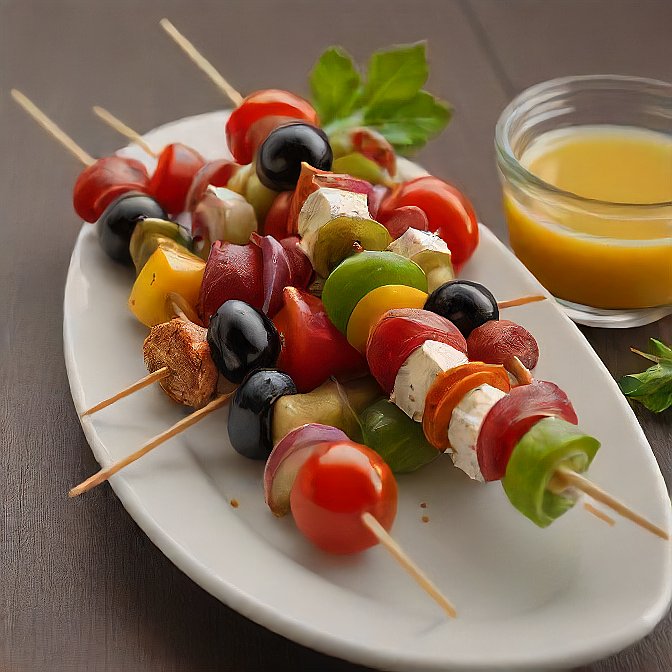Antipasto skewers offer a delightful way to kickstart any meal, combining a variety of flavors and textures on a single stick. Originating from the traditional Italian antipasto, which means “before the meal,” these skewers are not just an appetizer but an art form, allowing for creativity in selection and arrangement of ingredients. They are perfect for gatherings, parties, or a simple family snack, catering to a wide range of tastes and dietary preferences. This article delves into the simplicity and elegance of preparing antipasto skewers, ensuring even beginners can master this dish with ease.
The journey into crafting the perfect antipasto skewers begins with understanding what antipasto is, followed by a detailed look at the ingredients required. From choosing the right meats and cheeses to selecting vegetables and other accompaniments, each component contributes to the final taste and presentation. Step-by-step instructions will guide readers through the process of assembling the skewers, from the basics of skewer construction to artistic presentation tips that will make the dish stand out on any table. Additionally, the article will cover essential storage and make-ahead tips to ensure the antipasto skewers remain fresh and flavorful, demonstrating that with a little preparation, anyone can add this Italian staple to their culinary repertoire.
What is Antipasto?
Antipasto, often translated as “before the meal,” is a traditional first course in Italian dining, akin to appetizers. The term itself is derived from the Latin root “anti” meaning “before” and “pastus,” which translates to “meal.” This course is designed to stimulate the appetite, setting the stage for the main meal that follows. It’s not just a dish but an invitation to the table, an introduction to the forthcoming culinary experience.
In Italy, antipasto varies significantly from one region to another, reflecting local tastes and ingredients. Typically, it includes a variety of items such as cured meats, olives, peperoncini, mushrooms, anchovies, artichoke hearts, and various cheeses like provolone or mozzarella. These are often served on a platter, allowing diners to serve themselves. This selection can also include seafood like shrimp or anchovies, and in some regions, preparations of saltwater fish and traditional southern cured meats like soppressata or ‘nduja are popular. In northern Italy, it is common to find different kinds of cured meats and mushrooms, and near lakes, preparations of freshwater fish are prevalent.
The presentation of antipasto is just as important as its contents. It’s carefully selected for its color, texture, and the ability to evoke all five senses, thus enhancing the overall dining experience. Restaurants, in particular, place great emphasis on the presentation, adding elaborate dishes such as seafood salads, stuffed mushrooms, and vitello tonnato to their antipasto offerings.
Antipasto is not just reserved for special occasions in Italy; it’s a staple in Italian restaurants worldwide, often found on buffet tables or in refrigerated bars where guests can help themselves. The finer the restaurant, the more emphasis is placed on this course, allowing guests to taste truly creative and unusual specialties. The artful arrangement and the complementary flavor pairings of antipasti not only remind guests of the meal’s impending pleasures but also serve to change the entire mood of a gathering, luring each guest to the table for a shared meal among friends or family.
This course, with its rich variety and artistic presentation, is not just a precursor to the main meal but a showcase of culinary artistry, inviting diners to unwind and indulge in a prelude to the flavors that await.
Ingredients Needed for Antipasto Skewers
Cheeses
For the cheese component of antipasto skewers, options vary from soft to firm cheeses. Key choices include creamy bocconcini, often marinated to enhance flavor, and baby mozzarella balls, which provide a soft, mild taste. For those who prefer a different taste, cheddar, pepper jack, or other cubed firm cheeses are excellent substitutes. Some may opt for mozzarella balls coated in pesto for an added burst of flavor.
Meats
Italian meats are central to the skewers’ appeal, offering a range of flavors and textures. Commonly used meats include thin slices of Genoa salami, prosciutto, and occasionally, pepperoni or sweet bologna. These meats can be folded or rolled to fit neatly on the skewers. For a varied flavor profile, mixing different types of Italian meats such as capicola and mortadella is recommended.
Vegetables
Vegetables add freshness and a crisp texture to the skewers. Cherry or grape tomatoes are ideal for their size and sweetness, balancing the savory meats and cheeses. Artichoke hearts, either marinated or plain, introduce a tender yet firm texture. For those seeking variety, marinated mushrooms, chilled grilled asparagus, or roasted red peppers are also great additions. Fresh spinach leaves can be included for a nutritional boost.
Other Additions
To complete the skewers, a few other ingredients are essential. Olives, whether kalamata, garlic, or chili-stuffed, add a briny depth. Fresh basil leaves or other herbs like mint or parsley provide a pop of color and freshness. For a spicy kick, a dash of Tabasco sauce can be mixed into the marinade. Additionally, sun-dried tomatoes intensify the tomato flavor and contribute to the skewers’ Italian flair.
By combining these ingredients, one can create antipasto skewers that are not only visually appealing but also deliciously varied in taste and texture.
Step-by-Step Instructions
Marinating the Cheese and Tortellini
Begin by combining bocconcini and 2 tablespoons of Italian dressing in a bowl. Allow the cheese to marinate for at least 2 hours, or ideally overnight, to enhance its flavor. Meanwhile, after cooking the tortellini, toss it with Italian dressing and let it marinate for about an hour. This process not only flavors the pasta but also ensures it absorbs the dressing, adding a zesty taste to each bite.
Cooking the Tortellini
To prepare the tortellini, bring a large pot of water to a boil and cook the pasta according to the package instructions. Once cooked, drain the tortellini and quickly rinse under cold water to stop the cooking process. This step is crucial as it prevents the tortellini from becoming too soft or mushy, maintaining its ideal texture for the skewers.
Preparing the Skewers
Once the tortellini and cheese are marinated, start assembling the skewers. Use 6-inch wooden skewers for best results. Begin by skewering a basil leaf, then add a piece of the marinated cheese, a tortellini, and follow with a square of red bell pepper. Continue by adding a piece of poblano pepper and a cube of mozzarella. It’s important to alternate colors and textures to create visually appealing skewers.
For the meat, choose options like prosciutto di Parma, salami, or pepperoni. Cut the meat into smaller pieces and fold or roll them to fit neatly on the skewer. Add marinated vegetables like artichoke hearts and olives, ensuring a variety of flavors. Fresh herbs like basil or parsley can be added for a burst of color and freshness.
As you assemble the skewers, keep the arrangement consistent for a uniform look. Start with the fresh herb, add the meat, then alternate between the rest of the ingredients, finishing with an olive at the top. This pattern not only ensures each skewer is packed with flavor but also maintains an attractive presentation.
Once assembled, the skewers can be refrigerated until ready to serve. Just before serving, consider drizzling them with a lemon basil vinaigrette or a simple blend of olive oil and balsamic vinegar to enhance their flavor. Serve the skewers cold or at room temperature, as they taste best when not served too chilled.
By following these steps, one can create delicious and aesthetically pleasing antipasto skewers that are perfect for any gathering or event.
Assembling the Skewers
Threading the Ingredients
To begin assembling the antipasto skewers, one should start with a 6-inch wooden skewer. The assembly process involves threading various ingredients, ensuring each skewer is both visually appealing and delicious. Begin by placing a fresh herb, such as a basil leaf, at the base. Next, add a folded slice of prosciutto or salami, providing a sturdy base for the other ingredients. Continue by threading a marinated mozzarella cube, followed by a tortellini and a ripe olive. It is beneficial to alternate between different meats, such as prosciutto, Genoa salami, and pepperoni, which add varied savory flavors. Each skewer should also include an artichoke heart or a piece of pepper to introduce different textures and tastes.
Alternating Colors and Textures
The art of antipasto skewer assembly lies in the visual presentation as much as the taste. Alternating colors and textures is crucial for creating an enticing appetizer. One should ensure that no two similar colors are adjacent; for instance, a vibrant red tomato should not be next to a piece of red bell pepper. Instead, it could be placed next to a green basil leaf or a white mozzarella ball, enhancing the skewer’s visual appeal. The sequence of threading should be consistent across all skewers to maintain uniformity and elegance. This consistent pattern not only makes the skewers aesthetically pleasing but also ensures that each bite is a balanced mix of flavors and textures.
By paying attention to the order of ingredients, focusing on a harmonious blend of colors and textures, and repeating this pattern for each skewer, one can create a visually stunning and delicious array of antipasto skewers. These skewers will not only be a feast for the eyes but also a delightful precursor to any meal, embodying the spirit of traditional Italian antipasto.
Presentation Tips
Arranging Skewers
When presenting antipasto skewers, consistency in arrangement enhances both the visual appeal and the ease of eating. Start by threading a fresh herb, like a folded basil leaf, at the base of each skewer, followed by a sturdy slice of meat such as prosciutto or salami. This base supports the additional items. Continue by alternating the ingredients, such as a cherry tomato or a mozzarella cube, ensuring that each skewer mirrors the others for uniformity. It’s beneficial to leave enough space at the bottom of the skewer to allow for easy handling. Arrange the completed skewers on a platter or board in a neat, organized fashion, maintaining the same pattern across all to keep them looking consistent and attractive.
Adding Garnishes and Drizzles
To elevate the presentation of antipasto skewers, consider adding a final touch with garnishes and drizzles. A light sprinkle of dried oregano or fresh herbs can add a burst of flavor and color. For a more dynamic taste, drizzle a high-quality extra virgin olive oil or a balsamic reduction over the skewers just before serving. These additions not only enhance the flavor but also make the skewers visually more appealing. For a special touch, a drizzle of pomegranate molasses or balsamic glaze can be applied at the last minute, providing a sweet and tangy contrast to the savory components of the skewers.
Storage and Make-Ahead Tips
Antipasto skewers are an excellent choice for pre-event preparation, allowing hosts to enjoy their gatherings without last-minute kitchen hustle. Here are some essential tips to store and prepare these skewers in advance, ensuring they remain fresh and appealing.
Refrigeration Tips
For those who wish to prepare antipasto skewers ahead of time, they can assemble the skewers and store them in the refrigerator. It’s crucial to place them in an airtight container or cover the plate tightly with plastic wrap to maintain freshness. They can be refrigerated like this for up to 2-3 days. If one prefers to store the ingredients separately, they should deconstruct the skewers and keep the ingredients in individual containers. This method also helps the ingredients last longer, staying fresh for up to three days in the refrigerator. When ready to serve, they can simply reassemble the skewers, ensuring the flavors are as vibrant as when they were first prepared.
Avoiding Sogginess
To prevent sogginess, which can detract from the texture and overall enjoyment of the skewers, it’s important to handle the ingredients carefully. Do not wipe off any existing flavors from the ingredients; instead, ensure to drain as much excess liquid as possible before assembly. This approach keeps the textures intact and prevents the skewers from becoming soggy. If the skewers are prepared in advance, avoid adding any dressing or sauces until just before serving. This maintains the integrity of each ingredient, allowing guests to experience the intended crisp and fresh textures.
Conclusion
Throughout this guide, we’ve navigated the delightful journey of creating antipasto skewers, from selecting the perfect blend of ingredients to the art of assembly and presentation. The simplicity and elegance of antipasto skewers have been demystified, showcasing that with a little creativity and preparation, anyone can master this Italian appetizer. The importance of ingredient selection, marination, and alternating colors and textures for visual appeal underlines the essence of crafting the perfect skewer. These steps not only enhance the flavors but also transform the skewers into a visually stunning array that promises to be a feast for the senses, embodying the spirit of traditional Italian antipasto in every bite.
As we conclude, let this guide inspire you to embrace the art of antipasto skewer making for your next gathering, party, or family snack. The broader implication of mastering such a versatile dish extends beyond merely satiating appetites; it contributes to the richness of shared meal experiences, inviting diners to a communal table filled with laughter, stories, and, most importantly, beautiful food. Remember, the true beauty of antipasto skewers lies not just in their taste but in the shared joy they bring, cementing their place as a staple in culinary celebrations. With these insights, may your next culinary endeavor not only delight the palate but also enrich the soul.
FAQs
What is the ideal length for skewers used in preparing appetizers?
Skewers used for appetizers typically range from 4 to 6 inches in length. This size is perfect for presenting bite-sized appetizers on platters or for adding garnishes to drinks in rocks glasses or cocktail coupes.
What does ‘antipasto’ refer to in a meal setting?
Antipasto, an Italian term meaning “before the meal,” is a starter typically served at the table. It can range from simple offerings like a bowl of olives to more elaborate assortments of cured meats, cheeses, and vegetables served family-style.
What are some serving suggestions for antipasto?
Antipasto can be enhanced with various condiments such as spicy pepper spreads or sweet fig jam. These can be spread on crackers or bread, then topped with cheese or meat, or simply paired with cheese or dried fruit. It is advisable to choose at least two types of spreads, balancing salty cheeses with sweet spreads and mild cheeses with savory or mild spreads.
How many calories does one antipasto skewer contain?
A single antipasto skewer typically contains approximately 66 calories, which includes 5 grams of fat (1 gram saturated fat), 9 milligrams of cholesterol, 315 milligrams of sodium, 4 grams of carbohydrates (0 grams of sugars and fiber), and 2 grams of protein.

Antipasto Skewers Recipe
Ingredients
- 24 cherry tomatoes
- 24 small mozzarella balls bocconcini
- 24 basil leaves
- 24 slices of salami
- 24 black or green olives
- 24 small artichoke hearts canned or marinated
- 24 small pickled pepperoncini
- 24 small pieces of roasted red bell pepper
- 24 wooden skewers or toothpicks
Balsamic glaze for drizzling)
Olive oil for drizzling)
Salt and pepper to taste)
Instructions
- Rinse and pat dry the cherry tomatoes and basil leaves.
- Drain and pat dry the mozzarella balls, olives, and artichoke hearts.
- Cut the roasted red bell pepper into bite-sized pieces.
- Fold the salami slices in half or into quarters, if needed, to fit on the skewer.
- Assemble the skewers by threading one piece of each ingredient onto the wooden skewers or toothpicks in any desired order.
- Arrange the skewers on a serving platter.
- Optional: Drizzle with balsamic glaze and/or olive oil.
- Optional: Season with salt and pepper to taste.
- Serve immediately or refrigerate until ready to serve.

